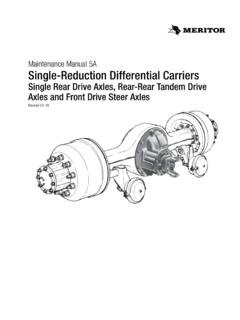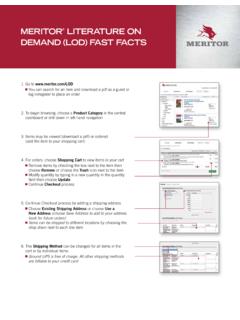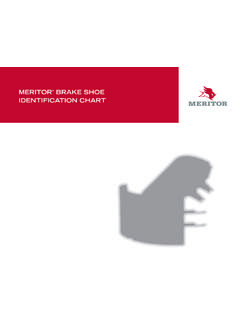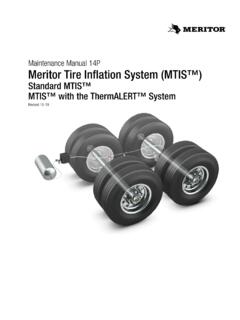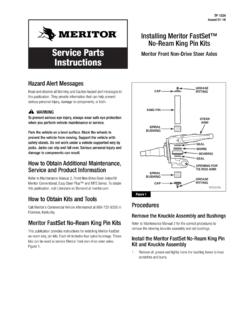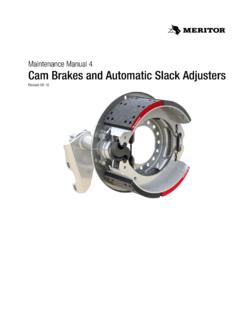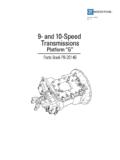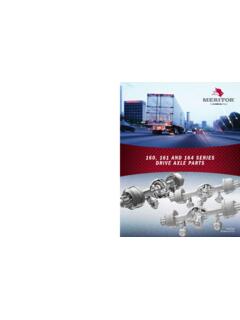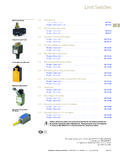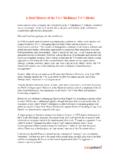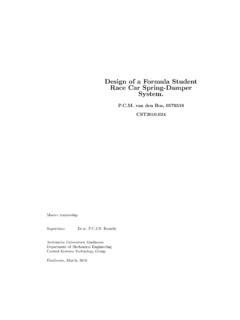Transcription of EUCLID SELF-ADJUSTING CLUTCH - graphicvillage.org
1 EUCLID SELF-ADJUSTING CLUTCHFEATURES AND No complicated reset proceduren Resets with manual adjustern Same procedure as manual adjust clutchInstallationn No need to retrain techniciansn Same installation procedure as manual adjust clutchWill NOT Over-Adjustn Not susceptible to outside forces ( while backing into dock or when hitting potholes during disengagement)Contamination-Prevention Technologyn self -contained components in adjuster maintain optimal adjusting functionn Patented Actively Expanding Seal ( ) creates an industry-first anti-contamination enclosuren Specialized lubrication ensures optimal adjustments throughout the life of the clutchRobust Adjuster Designn Positively engaged ratchet systemn 4-lug drive gear has the capability to deliver over 50 lb-ft of torque to the adjusting ringn self -locking worm gear ensures positive adjustmentNew Bearing Cage Designn Wider release bearing lugs and additional grease fittings to accommodate various linkage systemsEuclid SELF-ADJUSTING clutches deliver uncompromising quality because precision-engineering goes into every unit.
2 Our partner-supplier utilizes ISO 9001 quality control in every step of its design and manufacturing processes. The result: a CLUTCH that delivers optimum performance and low-cost operation supported by a name that s been relied on in the commercial vehicle industry for over 75 years. EUCLID . The Most Trusted Name In Truck CLUTCH AvailabilityPart NumberDescriptionEaton x 2, 4 paddle, 7 spring, 1700 lb-ft209701-82* x 2, 6 paddle, 7 spring, 2050 lb-ft209701-25* x 2, 4 paddle, 9 spring, 1700 lb-ft209701-51* x 2, 6 paddle, 9 spring, 2050 lb-ft209701-92** References to manufacturer s trade names and part numbers for identification only. Ideal for vehicles that utilize a hydraulic linkage system; can be used for both mechanical and hydraulic linkage all-makes clutches offer real peace of mind with one of the industry s best warranties 24-month coverage against defects in material and workmanship.
3 **See Meritor publication PB-1245 for complete slows down proper functionality faster than road contaminants and debris. EUCLID SELF-ADJUSTING clutches feature advanced contamination-prevention technology to help keep them operating smoothly. n Drive gear is contained within the worm gear to keep contaminants out of the drive lugsn Wave spring is contained within drive arm to keep out contaminants so that the spring can flex freely during ratchet functionPatented Actively Expanding Seal ( ) is housed in the adjusting ring to eliminate contamination-related failures caused by road grime, dust and other thread lube is used to reduce friction in adjusting ring/cover threads and to prevent rust and other corrosion issues resulting in premature Drive Gearn Worm Gearn Drive Armn Wave LIFE TEST OVER WEARLoss of Plate Load BeginsRelease Bearing SetPointBearing Height AmountLoss of Free Play and Loss of Plate Load BeginsWear (In)Bearing Height (In)HOW IT SELF-ADJUSTING clutches are designed to operate smoothly and efficiently, providing optimum performance.
4 During CLUTCH disengagement, if release bearing travel is 1/2 or less, no adjustment is necessary and the built-in lost motion window ensures an optimal release bearing the CLUTCH wears, release bearing travel increases beyond lost motion window and advances the worm gear. The worm gear then turns the adjusting ring to compensate for wear, repositioning the release CLUTCH engagement, the one-way ratchet advances and restores the ideal lost motion LUG LOST MOTIONT otal Lost Motion Represents 1/2 Bearing Travel7. 5 To o t h Travel EUCLID SELF-ADJUSTING CLUTCH is just that SELF-ADJUSTING . It has been developed and designed for efficiency and ease of maintenance. With its robust adjuster design, the EUCLID SELF-ADJUSTING CLUTCH eliminates the need for additional maintenance hours. If for any reason the CLUTCH needs to be reset or manually adjusted, a simple reset procedure may be followed, without the need to remove the CLUTCH .
5 1. Remove the SELF-ADJUSTING mechanism (shown right)2. Disengage the clutch3. Install manual adjust mechanism (shown below)4. Manually adjust the CLUTCH to meet specs during the set-up procedure5. Reinstall the SELF-ADJUSTING mechanism. Ensure the adjusting arm is properly seated in the retainer stud as shown below6. Before reinstalling the SELF-ADJUSTING mechanism, it may be necessary to ratchet the self -adjuster by actuating the auto adjust lever by hand so that the worm gear is seated properly in the adjusting ring teeth. For reinstallation, bolt the SELF-ADJUSTING mechanism into the CLUTCH assembly and visually verify that the worm gear is properly seated (refer to image below).IncorrectCorrectSelf-AdjusterMech anical AdjusterFREQUENTLY ASKED : What are the components that make up the CLUTCH assembly?A: The CLUTCH cover assembly (release bearing, adjuster, levers, pressure springs, adjusting ring, retainer, sleeve and pressure plate), the CLUTCH discs and the intermediate plate.
6 Related components include: CLUTCH brake, input shaft, transmission bearing retainer, input shaft pilot bearing, release fork, cross shafts, cross shaft bushings and : How do the CLUTCH assembly components interact with the following vehicle components: Engine, transmission, CLUTCH linkage, CLUTCH housing and flywheel?A: The CLUTCH cover assembly, the intermediate plate and the discs are mounted to the engine flywheel and rotate with the engine crankshaft. The CLUTCH discs are mounted on the transmission input shaft and rotate with the transmission input shaft. The CLUTCH assembly engages and disengages by means of mechanical or hydraulic linkage moving the release bearing fore and aft on the input shaft. The CLUTCH brake is engaged by the transmission linkage with the vehicle stopped to allow the input shaft to stop rotation and place the transmission from neutral to a forward or reverse gear, without grinding of the transmission CLUTCH collar teeth.
7 The pilot bearing is pressed into the engine crankshaft and supports the end of the input shaft, where the input shaft enters the : How does the CLUTCH operate when engaged and disengaged?A: The pull type CLUTCH is mechanically engaged and disengaged by the CLUTCH pedal. When ENGAGED, the springs in the cover push the pressure plate toward the engine flywheel, pressing the driven discs and the intermediate plate into the flywheel. When DISENGAGED, the CLUTCH pedal pulls the CLUTCH release bearing, releasing the spring tension from the pressure plate. The driven discs move away from the flywheel and the intermediate plate, disengaging the engine from the : What is the purpose of the CLUTCH brake and how does it work?A: The CLUTCH brake is needed when a pull type CLUTCH is installed in a vehicle with a non-synchronized transmission. The CLUTCH brake is mounted on - and connected to - the transmission input shaft.
8 The CLUTCH brake is meant to stop the rotation of the input shaft while the CLUTCH is disengaged when the vehicle is stopped with the engine at idle. This allows the driver to engage the transmission into a forward or reverse gear from neutral, without grinding the transmission gears. When the driver disengages the CLUTCH at the end of the CLUTCH movement, or approximately one inch from the floor of the vehicle, the CLUTCH pedal pulls the CLUTCH release bearing rearward. This compresses the stationary release bearing and rotates the CLUTCH brake against the stationary transmission input shaft bearing retainer, stopping the rotation of the CLUTCH brake, which is splined to the transmission input : How often does a EUCLID manual adjust CLUTCH need adjustment?A: The CLUTCH disc, the flywheel, the intermediate plate and the pressure plate wear differently, depending upon the vehicle application ( a linehaul tractor will generally not need CLUTCH adjustment as often as an off-highway dump truck).
9 However, the CLUTCH adjustment /component wear should be checked during each vehicle preventive maintenance inspection. Q: How often does a EUCLID SELF-ADJUSTING CLUTCH need adjustment?A: The CLUTCH disc, the flywheel, the intermediate plate and the pressure plate wear differently, depending upon the vehicle application ( a linehaul tractor will generally not need CLUTCH adjustment as often as an off-highway dump truck. Even though the CLUTCH is SELF-ADJUSTING , CLUTCH adjustment/component wear should be checked during each vehicle preventive maintenance inspection. Q: How often should a EUCLID manual or a EUCLID SELF-ADJUSTING CLUTCH need preventive maintenance inspection and lubrication?A: The CLUTCH disc, the flywheel, the intermediate plate and the pressure plate wear differently, depending upon the vehicle application ( a linehaul tractor will generally not need CLUTCH adjustment as often as an off-highway dump truck).)
10 However, CLUTCH adjustment/component wear should be checked during each vehicle preventive maintenance inspection. The release bearing and the CLUTCH linkage should be lubricated during each vehicle preventive maintenance inspection. Q: What CLUTCH assembly-related components require inspection or replacement when replacing with a new CLUTCH assembly?A: Resurface or replace the flywheel, install a new pilot bearing and CLUTCH brake. If worn, replace the input shaft, cross shaft bushings, cross shafts, release bearing fork, control linkage and the transmission bearing : If the above mentioned components are not inspected and replaced, how might this affect the new CLUTCH assembly operation and life?A: A damaged or worn pilot bearing, worn input shaft, worn cross shaft bearings, worn release bearing fork or worn control linkage can cause a new CLUTCH assembly to hang-up, resulting in poor release or engagement of the CLUTCH assembly.

